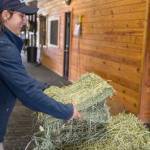Don’t Flake Out: Feed Horse Hay by Weight, Not by Flake

Whoever invented modern hay-baling equipment garners far too little praise from horse owners. The concept of dividing unwieldy bales into flakes, or biscuits, qualifies as sheer genius.
Despite off-the-chart convenience, conscientious horse owners maintain a niggling uneasiness about feeding hay by the flake. What is it that bothers them?
Feeding aficionados probably hit on the problem quickly. It is another case of feeding by volume, not by weight, akin to feeding a scoop of this feed or a dipper of that feed, rather than a specific quantity based on weight.
“To maintain body condition, horses typically consume about 1.5-2% of their body weight on a dry matter basis each day in concentrates and forage, with the forage component accounting for 1-1.5% of body weight for most horses,” said Catherine Whitehouse, M.S., nutrition advisor at Kentucky Equine Research (KER).
Example: a large pony weighs 800 lb (365 kg) and could be expected to consume 12-16 lb (5.5-7 kg) of feed per day, with 8-12 lb (3.6-5 kg) of that forage.
With those calculations in mind, how many flakes of timothy hay would the pony require daily? Two or three? Five or six? Half a bale? Can a reasonable calculation be made with only this information?
The missing factor in this feeding puzzle is an estimation of how much each flake weighs. As anyone that’s unloaded wagons of hay can attest, weight of hay varies, sometimes a lot!
Some hay is fluffy and light, and weighs little; other hay is densely packed and weighs more than expected. So, it’s best to find a portable scale of some kind—a fishing scale is an easy-to-find solution—and measure several flakes from different bales, carefully noting each weight. An average of the weights provides a representative estimate that can be used to determine consumption.
Assuming the orchardgrass/timothy hay in our scenario weighs 3 lb (1.4 kg) per flake, it is easy to calculate how much the pony requires daily: three to four flakes.
This provides a sound basis for forage consumption. Factors may change this allotment: time on pasture, amount of work, or desired body condition changes.








